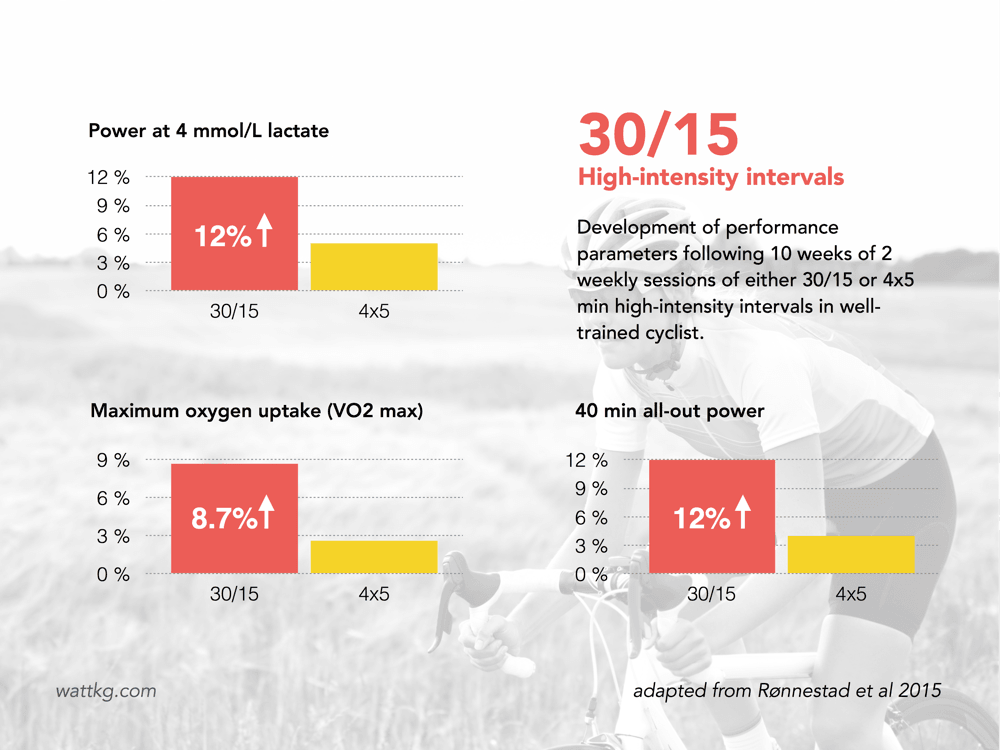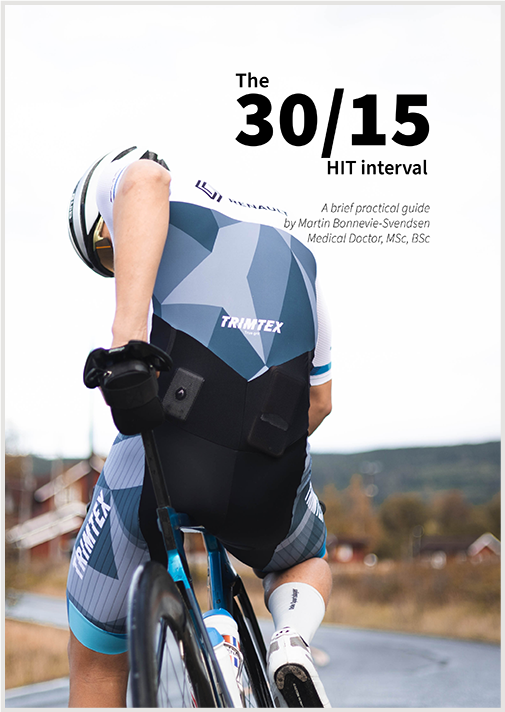Both long and short intervals are common elements of most cycling training plans.
But, how do you know which interval design will provide you with the biggest power output?
The best way to investigate this would be to gather a bunch of competitive cyclists with a comparable performance level. And have them train as similarly as possible, with the only difference being using different interval sessions.
Measure VO2 max, threshold power before and after the training period…
…and voila!
You could now analyse which group achieved the better development. This would indicate which interval format is more effective.
This is exactly what a group of scientists did when they compared the effect of long and short high-intensity intervals on competitive cyclists back in 2015 (1).
Featured image credit: Duncan Andison/Shutterstock.com
Short intervals induce superior training adaptation compared with long intervals in cyclists
In this study, Rønnestad and colleagues compared the effects of 10 weeks of short intervals (SI) or long intervals (LI) (1).
Who were the cyclists?
20 male competitive cyclists partook in the study. Mean age was 33 and training volume in the 4 weeks leading into the study ranged from 8 to 10 hours per week. The mean VO2 max of the riders were approximately 66 ml/kg/min.
How did they train?
The cyclists were allocated to two groups undertaking either long or short intervals. For 10 weeks, the groups trained two weekly high-intensity interval sessions, interspersed with low-intensity training.
The LI groups performed a traditional 4 x 5 minute interval with 2.5 minute recovery periods between each interval. The SI group performed 30 second intervals separated by 15 second recovery periods. A total of 13 cycles of 30/15 (work/recovery) periods were completed before a 3 min recovery period took place. This 9.5 minute session was completed for a total of 3 times (for a total of 39 thirty second intervals).
How did they perform?
Before and after the 10 week period the cyclists undertook the following testing:
- Blood lactate profile
- VO2 max
- Wingate test (30 sec max effort)
- 5 min all-out trial
- 40 min all-out trial
During the training period, mean power of interval sessions increased by 9% in the SI group, with a 2% change in the LI group. Rate of perceived exertion was similar in the two groups, which indicates both interval formats were perceived as similarly tough.

After 10 weeks, maximum oxygen uptake (VO2 max) increased by 8.7% in the SI group, whereas the LI group improved by 2.6% only.
For research purposes, lactate threshold is often estimated to a blood lactate concentration of 4 mmol/L. Power output at 4 mmol/L increased by 12% in the group doing short intervals, compared to 5% improvement in the group doing long intervals.
For the 40 min all-out trial, mean power improved by 12% and 4% in the SI and LI group, respectively. Similarly, mean power during 5 min all-out trial increased by 8% in the SI group and 3% in the LI group.
There are several interesting aspects to this study that warrants further discussion.
Beating the well-documented control
If you do a quick search on 4×4 interval training you will see that it is one of the most commonly researched types of interval training. And with good results too.
Our study by Rønnestad uses 4×5 min high-intensity intervals, which very closely resembles the well-documented 4×4 format. And still, the 30/15 short interval beat the traditional interval format hands down.
This is a powerful statement to the potency of high-intensity short intervals.
Improved power across the board
Intuitively, it makes sense that the short interval improves performance at higher power outputs.
It is therefor interesting to note how the 30/15 interval induced the highest performance gains at both higher and lower power outputs. Power over 30 sec max effort, 5 min all-out, 40 min all-out and at approximate lactate threshold all improved with the short interval format.
By contrast, the long interval format failed to induce significant improvements in 5 min all-out and 30 sec max effort. These are arguably important performance qualities, especially when it comes to race performance (think sprints, breakaways and short and steep hills).
Why does 30/15 seemingly induce greater performance than 4×5?
In this study, both interval formats had a comparable duration of interval work. The short and long interval sessions had a total high-intensity work duration of 19.5 and 20 minutes, respectively.
So, why does one perform better than the other?
The authors suggest several possible explanations.
1) The 2:1 work to recovery ratio, combined with the long duration of each series (9.5 min) allows the riders to achieve relatively large cardiovascular stress. Rønnestad et al suggests that the 30/15 format allows for more training time above 90% of VO2 max, and thus greater training stimulus.
2) Furthermore, Rønnestad and colleagues highlight that it has been suggested that time spent at high intensity has an additive effect on muscular adaptation. It is not unreasonable to assume that the short intervals involve a higher power output than what can be sustained for 5 minutes of consecutive work. This might contribute to larger training stimulus than the 4 x 5 protocol.
3) Finally, the authors raise the question whether larger exposure to lactate stress could explain the superior adaptation from short intervals. Although groups had similar lactate values after the sessions, it might be that the short interval format allowed a higher lactate concentration throughout the session.
The initial two arguments above should be easy enough to explore for yourself. If explanation #1 (more time >90% VO2 max) holds true, you would expect the short interval to accumulate more time on high heart rate values. Similarly, if explanation 2 (higher average power) is correct, you should be able to replicate this finding for yourself.
If you possess a heart rate monitor or power meter, it would be a neat little experiment to see for yourself.
EDIT: A more recent publication by the same lead author has demonstrated the effects of the 30/15 interval on elite riders.
How to perform the 30/15 interval format yourself
In my experience, the short interval format described in this study can be successfully adopted by most cyclists.
However, you would probably do well in adjusting the total number of high-intensity bursts to suit your fitness level.
I have added a PDF with some comments you might want to consider.
Get the 30/15 HIT interval & other workout instructions in my free newsletter

When you subscribe to my newsletter you will receive the sprint-in-LIT and other workout instructions, science reviews and discussions of best training practices. There is also occasional information about my paid services. I will take care not to clutter your inbox.
Good luck with your short interval training!
PS! You may also experiment with using the above 30/15 sessions with a fast start interval style.
Caveats
A few words of caution should be mentioned in interpreting the results of this study.
Although the number of participants in this trial (20) is not uncommon in these kind of studies, ideally the number could have been higher. In short, the greater the number of participants, the less likely random chance is to affect the outcome.
Furthermore, the authors state that both groups trained a similar amount and with comparable distribution of intensity (including HIIT) in the four weeks leading into the trial. However, there is no mention of what kind of high-intensity training they performed prior to the trial.
It could be hypothesised that if these riders were already accustomed to a 4×5-like interval format, they would be less likely to achieve progress with the same format, as compared to varying their training stimuli with a new interval format, such as 30/15.
If, and to what extent this mechanism has impacted the results, I cannot say.
The above represents examples of why we always put most faith in research findings when multiple studies reproduce consistent results. As for the 30/15 interval, we still have to wait for these results to be reproduced in the cycling population.
Take-home message
This study reports large performance gains in well-trained cyclists with high-intensity short intervals in the format of 30/15 second work and recovery cycles.
By comparison, the short interval format yielded greater performance enhancement across high and low power outputs when compared with the traditional 4 x 5 minute interval (although statistical significance was not achieved across all parameters).
It would certainly be premature to suggest the 30/15 session as an ultimate interval solution for all riders. More likely, this format of short high-intensity intervals may be regarded as a potential way of varying training stimuli to gain additional endurance capacity.
There is still much ground to cover before we fully understand how to best implement different types of interval training. That being said, the 30/15 short interval might be a useful workout to have in your quiver of high-intensity sessions.
This post the first of many in a series of articles discussing recent research on interval training. You can get the complete series of articles to your inbox by signing up for my newsletter. Sign-up is free and you can unsubscribe at any time.
References:
- Rønnestad BR et al. Short intervals induce superior training adaptations compared with long intervals in cyclists – An effort-matched approach. Scandinavian Journal of Medicine & Science in Sports, 2015;25:143-151
